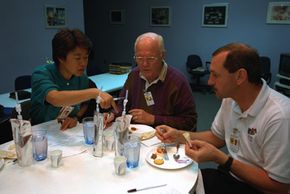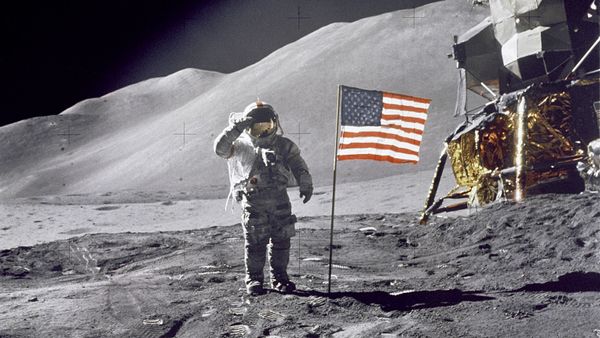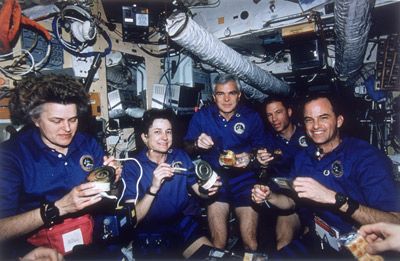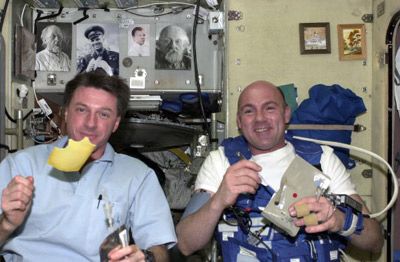Space Food Research and Development
There are eight types of food processing techniques used by the Space Food Systems Laboratory. The food types are: rehydrated, thermostabilized, irradiated, intermediate moisture, natural form, fresh, refrigerated and frozen [For more information about each type of food, visit How Space Food Works]. There are also beverages. Most foods are precooked or processed to require no refrigeration, and all are ready-to-eat or ready-to-be rehydrated or reheated.
NASA food scientists don't make food from scratch in a test kitchen. United States Alliance (USA) is contracted by NASA to manage space food provisioning. When the Space Food Systems Laboratory is running low on food items, USA purchases and restocks inventory from commercial suppliers (companies such as Pillsbury Co. and Oregon Freeze Dry, Inc.) or purchases fresh foods to be processed in-house. All foods provided by USA are then tested and evaluated in the Space Food Systems Laboratory for safety, nutrition and sensory properties (such as palatability) before they're made available to spaceflight crews.
Advertisement
About eight to nine months before their flight, astronauts take part in food evaluations as part of their training. Evaluations take place in the sensory booths at the Space Food Systems Laboratory. Astronauts sample a variety of foods and drinks (eating crackers and water between each tasting) and score each food on characteristics such as flavor, texture, appearance and aroma. These scores help the lab put together sample menus.
In addition to food evaluations, scientists gather astronaut feedback through crew debriefings. Scientists examine the trash and leftovers from missions, looking specifically at what astronauts did and didn't eat.
Astronaut likes and dislikes are instrumental to food and packaging progress -- they suggest foods, changes to packaging and stowage techniques.
About five months before their flight, astronauts choose their menu from more than 200 foods [source: Johnson Space Center]. Dietitians then analyze each menu for nutritional content, identifying deficiencies and modifying meal plans before menus are finalized.
Menus are designed to meet each individual's nutritional needs and Recommended Dietary Allowances (RDA) for vitamins and minerals. Scientists use a formula for basal energy expenditure (BEE) provided by the National Research Council to determine individual caloric requirements:
For women, BEE = 655 + (9.6 x W) + (1.7 x H) - (4.7 x A).
For men, BEE = 66 + (13.7 x W) + (5 x H) - (6.8 x A)
W = weight in kilograms, H = height in centimeters and A = age in years
[source: NASA]
In addition to balancing nutritional and caloric needs with astronaut preferences, dietitians also take the crew's psychological state into consideration. The team at the Space Food Systems Laboratory tries to send along off-the-menu comfort foods, stocking bonus containers with commercial candy bars, cookies and crackers.
There's also ongoing research on the nutritional risks during space flight, including exposure to increased radiation in orbit, psychological issues and bone health. Scientists study the crew's food intake, body weight and composition and bone mass during shuttle flights and missions to the International Space Station for insights into how nutritional assessment changes can minimize these health risks in the future.
Menus are finalized three months before liftoff, and shuttle food contractors at the Space Food Systems Laboratory manage the food packaging and storage for the mission.
On the next page, we'll see how foods are processed and packaged at the Space Food Systems Laboratory. We'll also find out why every package has a barcode and colored dot on it.



